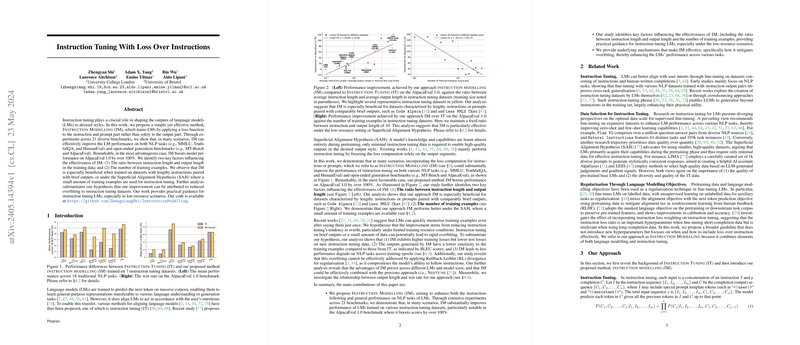Instruction Modelling: A Simplified Approach to Better Align LLMs
Introduction
Hey there, data science enthusiasts! Today, let's dive into a fascinating new method called Instruction Modelling (IM). This approach focuses on enhancing the way we instruct our beloved LLMs (LMs). We'll break down what this research entails, highlight some intriguing results, and explore its practical and theoretical implications. So, grab a coffee and let's get into it!
What's the Big Idea?
In today's world, getting LMs to perform well involves instruction tuning (IT), where we fine-tune these models on datasets containing specific instructions and their corresponding outputs. However, the traditional IT method only considers the loss (a measure of error) for the output, ignoring the instructions themselves. IM, on the other hand, proposes a twist: it applies the loss function to both instructions and outputs. Simple, right? Yet, this little tweak has shown noteworthy improvements across various benchmarks.
Key Findings
- Boost in Performance: When evaluated across 21 diverse benchmarks, IM consistently improves performance on both traditional NLP tasks like MMLU and open-ended generation tasks like AlpacaEval. For instance, IM boosts performance on AlpacaEval 1.0 by over 100% in the best-case scenario. That's a significant jump!
- Two Crucial Factors:
- Instruction Length to Output Length Ratio: IM works wonders with datasets where instructions are lengthy, but outputs are short. This is because longer instructions provide more context, reducing the chance that the model overfits on the outputs alone.
- Number of Training Examples: IM shines in environments with fewer training examples. Yep, less can be more in this case. It aligns well with the Superficial Alignment Hypothesis, suggesting that the real necessity is high-quality pre-trained models and just enough instruction-tuning data to align them appropriately.
Below are some impressive results:
- Alpagasus Dolly 9k Dataset:
- Traditional Instruction Tuning (IT) Mean NLP Score: 45.54
- Instruction Modelling (IM) Mean NLP Score: 48.00
- Improvement: +2.46 points
- Less MMLU Chat Dataset:
- IT Win Rate on AlpacaEval 1.0: 4.42%
- IM Win Rate on AlpacaEval 1.0: 9.78%
- Improvement: Over 100%
Why Does It Work?
The research suggests that IM mitigates the overfitting problem typically seen in IT. Here's why:
- Higher Training Loss but Lower Test Loss: IM shows a slightly higher training loss but a significantly lower test loss, indicating better generalization.
- Lower BLEU Scores: Outputs from IM have lower BLEU scores compared to IT, implying less similarity to training examples and thus, less overfitting.
- Lower Instruction Tuning Tax: In traditional IT, the model's performance on core NLP tasks can degrade over time due to overfitting. IM exhibits a lower degradation rate, maintaining better overall performance.
Practical and Theoretical Implications
- Practical Guidance: For those fine-tuning LMs, especially under low-resource scenarios, IM provides a robust framework. It’s a powerful method to retain high performance without needing a ton of data.
- Applications in AI Development: Academic and industry practitioners developing AI assistants or chatbots can leverage IM to build more reliable and versatile systems. It’s particularly useful in domains where training data is sparse but instructions are detailed.
Looking Forward
The future looks promising for IM. It could pave the way for more efficient and effective training methodologies, especially as we continue to push the boundaries of what LMs can accomplish. Some exciting areas to watch for include:
- Integration with Other Methods: Combining IM with techniques like Neftune can further enhance performance. However, it's essential to monitor specific conditions to maximize benefits.
- Exploring Output Length Dynamics: Understanding the relationship between output length and win rates in different contexts could offer deeper insights into optimizing LMs for varied applications.
Wrap-Up
And there you have it! Instruction Modelling introduces a straightforward yet powerful change in how we train LLMs, leading to significant enhancements in performance across a range of tasks. Whether you're diving into AI development or just curious about the latest advancements, IM is definitely a concept worth keeping an eye on.
Feel free to explore the code and more detailed results in their GitHub repository. Happy experimenting!
I hope this breakdown helps make the concepts of Instruction Modelling more accessible and sparks some creative ideas for your next AI project!
